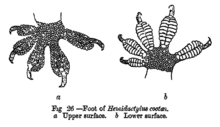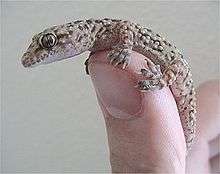Hemidactylus
| Hemidactylus | |
|---|---|
| | |
| Mediterranean house gecko, Hemidactylus turcicus | |
| Scientific classification | |
| Kingdom: | Animalia |
| Phylum: | Chordata |
| Subphylum: | Vertebrata |
| Class: | Reptilia |
| Order: | Squamata |
| Suborder: | Gekkota |
| Family: | Gekkonidae |
| Genus: | Hemidactylus Oken, 1817[1] |
| Type species | |
| Gecko tuberculosus | |
| Diversity | |
| Around 90 species, and see text | |
| Synonyms | |
|
In alphabetical order:
| |
Hemidactylus (the house geckos) is a genus of the family of common geckos, Gekkonidae. It has about 90 described species, newfound ones being described every few years. These geckos are found in all the tropical regions of the world, extending into the subtropical parts of Africa and Europe. They excel in colonizing oceanic islands by rafting on flotsam, and are for example found across most of Polynesia. In some archipelagoes, cryptic species complexes are found.[2] Geckos like to live in and out of houses. They are introduced to Australia.
They are typically known as house geckos, due to their readiness to adapt to and coexist with humans. This genus was originally established by Lorenz Oken in 1817 for the species at that time known as Hemidactylus tuberculosus, and now described as the tropical house gecko (Hemidactylus mabouia).[2]
Feces
A house gecko will usually confine its excretions to one area of a house. This is sometimes considered a nuisance by home owners, and may stain certain surfaces.[3] The feces are approximately five (5) millimeters in length, two (2) millimeters wide, and dark brown (almost black) in color.
Description

The dorsal lepidosis is either uniform or heterogeneous. The pupil of the eye is vertical. Males have pre-anal or femoral pores. Each finger or toe has a slender distal clawed joint, angularly bent and rising from within the extremity of the dilated portion.[4]
The fingers and toes are free, or more or less webbed, and dilated; underneath they bear two rows of lamellae in a pattern resembling a paripinnate compound leaf.[4] This leads to their other and more ambiguous common name, "leaf-toed geckos", used mainly for species from South Asia and its surroundings to prevent confusion with the many "leaf-toed" Gekkota not in Hemidactylus.
Species



- Hemidactylus aaronbaueri Giri, 2008
- Hemidactylus acanthopholis Mirza & Sanap, 2014
- Hemidactylus adensis Šmíd et al., 2014
- Hemidactylus agrius Vanzolini, 1978
- Hemidactylus albituberculatus Trape, 2012
- Hemidactylus albivertebralis Trape & Böhme, 2012
- Hemidactylus albofasciatus Grandison & Soman, 1963
- Hemidactylus albopunctatus Loveridge, 1947
- Hemidactylus alkiyumii Carranza & Arnold, 2012
- Hemidactylus anamallensis (Günther, 1875)
- Hemidactylus angulatus Hallowell, 1854
- Hemidactylus ansorgii Boulenger, 1901
- Hemidactylus aporus Boulenger, 1906
- Hemidactylus aquilonius McMahan & Zug, 2007
- Hemidactylus arnoldi Lanza, 1978
- Hemidactylus awashensis Šmíd et al., 2014
- Hemidactylus barbierii Sindaco, Razzetti & Ziliani, 2007
- Hemidactylus barodanus Boulenger, 1901
- Hemidactylus bavazzanoi Lanza, 1978
- Hemidactylus bayonii Bocage, 1893
- Hemidactylus beninensis Bauer, Tchibozo, Pauwels & Lenglet, 2006
- Hemidactylus biokoensis Wagner, Leaché & Fujita, 2014
- Hemidactylus boavistensis Boulenger 1906 (often included in H. bouvieri)
- Hemidactylus bouvieri (Bocourt, 1870)
- Hemidactylus bowringii (Gray, 1845) – oriental leaf-toed gecko
- Hemidactylus brasilianus Amaral, 1935
- Hemidactylus brookii Gray, 1845 – Brook's house gecko
- Hemidactylus citernii Boulenger, 1912
- Hemidactylus coalescens Wagner, Leaché & Fujita, 2014
- Hemidactylus craspedotus Mocquard, 1890
- Hemidactylus curlei Parker, 1942
- Hemidactylus dawudazraqi Moravec, Kratochvíl, Amr, Jandzik, Šmíd & Gvoždík, 2011
- Hemidactylus depressus Gray, 1842
- Hemidactylus dracaenacolus Rösler & Wranik, 1999
- Hemidactylus echinus O'Shaughnessy, 1875
- Hemidactylus endophis Carranza & Arnold, 2012
- Hemidactylus eniangii Wagner, Leaché & Fujita, 2014
- Hemidactylus fasciatus Gray, 1842
- Hemidactylus festivus Carranza & Arnold, 2012
- Hemidactylus flaviviridis Rüppell, 1835
- Hemidactylus forbesii Boulenger, 1899
- Hemidactylus foudaii Baha El Din, 2003
- Hemidactylus frenatus Schlegel, 1836 – common house gecko, Pacific house gecko, Asian house gecko
- Hemidactylus funaiolii Lanza, 1978
- Hemidactylus garnotii A.M.C. Duméril & Bibron, 1836 – Indo-Pacific gecko, Garnot's house gecko
- Hemidactylus giganteus Stoliczka, 1871– giant leaf-toed gecko
- Hemidactylus gracilis Blanford, 1870 – graceful leaf-toed gecko
- Hemidactylus granchii Lanza, 1978
- Hemidactylus graniticolus Agarwal, Giri & A.M. Bauer, 2011[5]
- Hemidactylus granti Boulenger, 1899
- Hemidactylus greeffii Bocage, 1886 – Greeff's gecko,[6] Greeff's giant gecko[7]
- Hemidactylus haitianus Meerwarth, 1901
- Hemidactylus hajarensis Carranza & Arnold, 2012
- Hemidactylus homoeolepis Blanford, 1881
- Hemidactylus hunae - spotted rock gecko
- Hemidactylus inexpectatus Carranza & Arnold, 2012
- Hemidactylus inintellectus Sindaco, Ziliani, Razzetti, Pupin, Grieco, 2009
- Hemidactylus intestinalis F. Werner, 1897
- Hemidactylus isolepis Boulenger, 1895
- Hemidactylus jubensis Boulenger, 1895
- Hemidactylus kamdemtohami A.M. Bauer & Pauwels, 2002
- Hemidactylus karenorum (Theobald, 1868) – Burmese leaf-toed gecko
- Hemidactylus klauberi Scortecci, 1948
- Hemidactylus kyaboboensis Wagner, Leaché & Fujita, 2014
- Hemidactylus laevis Boulenger, 1901
- Hemidactylus lankae - termite hill gecko
- Hemidactylus laticaudatus L.G. Andersson, 1910
- Hemidactylus leightoni Boulenger, 1911 (often included in H. brooki)
- Hemidactylus lemurinus Arnold, 1980
- Hemidactylus leschenaultii A.M.C. Duméril & Bibron, 1836 – Leschenault's leaf-toed gecko
- Hemidactylus longicephalus Bocage, 1873
- Hemidactylus lopezjuradoi Arnold, Vasconcelos, Harris, Mateo & Carranza, 2008 (formerly in H. bouvieri)
- Hemidactylus luqueorum Carranza & Arnold, 2012
- Hemidactylus mabouia (Moreau de Jonnès, 1818) – tropical house gecko, Afro-American house gecko, cosmopolitan house gecko
- Hemidactylus macropholis Boulenger, 1896
- Hemidactylus maculatus A.M.C. Duméril & Bibron, 1836 – spotted leaf-toed gecko
- Hemidactylus mahendrai Shukla, 1983
- Hemidactylus mandebensis Šmíd et al., 2014
- Hemidactylus marmoratus Hallowell, 1861
- Hemidactylus masirahensis Carranza & Arnold, 2012
- Hemidactylus matschiei (Tornier, 1901)
- Hemidactylus megalops Parker, 1932
- Hemidactylus mercatorius Gray, 1842
- Hemidactylus modestus (Günther, 1894)
- Hemidactylus muriceus Peters, 1870
- Hemidactylus newtoni Ferreira, 1897
- Hemidactylus ophiolepis Boulenger, 1903
- Hemidactylus ophiolepoides Lanza, 1978
- Hemidactylus oxyrhinus Boulenger, 1899
- Hemidactylus palaichthus Kluge, 1969
- Hemidactylus parvimaculata
- Hemidactylus paucituberculatus Carranza & Arnold, 2012
- Hemidactylus persicus J. Anderson, 1872 – Persian leaf-toed gecko
- Hemidactylus platycephalus W. Peters, 1854
- Hemidactylus platyurus (Schneider, 1792) – flat-tailed house gecko (sometimes in Cosymbotus)
- Hemidactylus porbandarensis Sharma, 1981
- Hemidactylus prashadi M.A. Smith, 1935 – Bombay leaf-toed gecko
- Hemidactylus pseudomuriceus Henle & Böhme, 2003[8]
- Hemidactylus puccionii Calabresi, 1927
- Hemidactylus pumilio Boulenger, 1899
- Hemidactylus reticulatus Beddome, 1870 – reticulate leaf-toed gecko
- Hemidactylus richardsonii Gray, 1845
- Hemidactylus ruspolii Boulenger, 1896 – farm leaf-toed gecko, Prince Ruspoli's gecko, Ruspoli's gecko, turnip-tailed black and yellow gecko
- Hemidactylus scabriceps (Annandale, 1906)
- Hemidactylus sinaitus Boulenger, 1885
- Hemidactylus smithi Boulenger, 1895
- Hemidactylus somalicus Parker, 1932
- Hemidactylus squamulatus Tornier, 1896
- Hemidactylus stejnegeri Ota & Hikida, 1989
- Hemidactylus subtriedrus Jerdon, 1854
- Hemidactylus tanganicus Loveridge, 1929
- Hemidactylus tasmani Hewitt, 1932
- Hemidactylus taylori Parker, 1932
- Hemidactylus thayene McMahan & Zug, 2007
- Hemidactylus triedrus (Daudin, 1802) – termite hill gecko
- Hemidactylus tropidolepis Mocquard, 1888
- Hemidactylus turcicus Linnaeus, 1758 – Mediterranean house gecko
- Hemidactylus vietnamensis Darevsky, Kupriyanova & Roshchin, 1984
- Hemidactylus yerburyi J. Anderson, 1895
References
- ↑ Dahms Tierleben. www.dahmstierleben.de
- 1 2 3 Lizards of the World (2004): Hemidactylus. Version of 2004-FEB-08. Retrieved 2009-APR-04.
- ↑ "House Geckos".
- 1 2 Boulenger, G.A. (1890). The Fauna of British India, Including Ceylon and Burma. Reptilia and Batrachia. London: Secretary of State for India in Council. (Taylor and Francis, printers). xviii + 541 pp. (Genus Hemidactylus, p. 82). Fulltext at the Internet Archive
- ↑ Angarwal, I., Giri, V.B., & Bauer, A.M. (2011). "A new cryptic rock-dwelling Hemidactylus (Squamata: Gekkonidae) from south India". Zootaxa 2765: 21-37.
- ↑ Beolens B, Watkins M, Grayson M. 2011. The Eponym Dictionary of Reptiles. Baltimore: Johns Hopkins University Press. xiii + 296 pp. ISBN 978-1-4214-0135-5. (Hemidactylus greeffii, p. 107).
- ↑ "Hemidactylus greeffii ". The Reptile Database. www.reptile-database.org.
- ↑ Henle, K., and W. Böhme. (2003). "A new species of Hemidactylus (Squamata: Gekkonidae) from West Africa, and comments on species hitherto confused with H. muriceus". African Journal of Herpetology 52 (1) 23-38.
External links
| Wikimedia Commons has media related to Hemidactylus. |